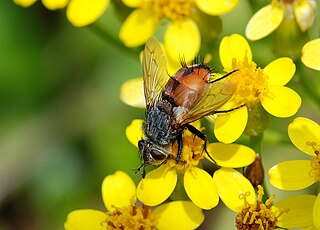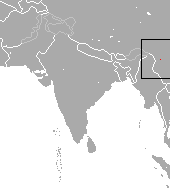
The ovipositor is a tube-like organ used by some animals, especially insects, for the laying of eggs. In insects, an ovipositor consists of a maximum of three pairs of appendages. The details and morphology of the ovipositor vary, but typically its form is adapted to functions such as preparing a place for the egg, transmitting the egg, and then placing it properly. For most insects, the organ is used merely to attach the egg to some surface, but for many parasitic species, it is a piercing organ as well.

The Integrated Taxonomic Information System (ITIS) is an American partnership of federal agencies designed to provide consistent and reliable information on the taxonomy of biological species. ITIS was originally formed in 1996 as an interagency group within the US federal government, involving several US federal agencies, and has now become an international body, with Canadian and Mexican government agencies participating. The database draws from a large community of taxonomic experts. Primary content staff are housed at the Smithsonian National Museum of Natural History and IT services are provided by a US Geological Survey facility in Denver. The primary focus of ITIS is North American species, but many biological groups exist worldwide and ITIS collaborates with other agencies to increase its global coverage.

The Brachycera are a suborder of the order Diptera. It is a major suborder consisting of around 120 families. Their most distinguishing characteristic is reduced antenna segmentation.

Saxifraga oppositifolia, the purple saxifrage or purple mountain saxifrage, is a species of plant that is very common in the high Arctic and also some high mountainous areas further south, including northern Britain, the Alps and the Rocky Mountains.

The name Apterygota is sometimes applied to a former subclass of small, agile insects, distinguished from other insects by their lack of wings in the present and in their evolutionary history; notable examples are the silverfish, the firebrat, and the jumping bristletails. Their first known occurrence in the fossil record is during the Devonian period, 417–354 million years ago. The group Apterygota is not a clade; it is paraphyletic, and not recognized in modern classification schemes. As defined, the group contains two separate clades of wingless insects: Archaeognatha comprises jumping bristletails, while Zygentoma comprises silverfish and firebrats. The Zygentoma are in the clade Dicondylia with winged insects, a clade that includes all other insects, while Archaeognatha is sister to this lineage.

The Entognatha are a class of wingless and ametabolous arthropods, which, together with the insects, makes up the subphylum Hexapoda. Their mouthparts are entognathous, meaning that they are retracted within the head, unlike the insects. Entognatha are apterous, meaning that they lack wings. The class contains three orders: Collembola, Diplura and Protura. These three groups were historically united with the now-obsolete order Thysanura to form the class Apterygota, but it has since been recognized that the hexapodous condition of these animals has evolved independently from that of insects, and independently within each order. The orders might not be closely related, and Entognatha is now considered to be a paraphyletic group.

Aleksandr Grigorevich Sharov was a Soviet palaeoentomologist, paleontologist and expert on Pterosauria. He graduated from Moscow State University. In 1951 he defended Candidate of Science dissertation on the embryology of Apterygota. Since 1951 he worked at the Paleontological Institute in Moscow, where in 1966 he defended dissertation of Doctor of Science. His major contribution to the phylogeny of Arthropods was published in 1966. He worked during the 1960s and 1970s on the Karatau rocks and discovered many of the fossils, of which some have been named after him, as in the case of the Karatausuchus sharovi, and Sharovipteryx. He also discovered and described the specimen Sordes pilosus in 1971 and Longisquama insignis.

Aptery is the anatomical condition of an animal completely lacking any kind of wings. An animal with this condition is said to be apterous.

The Eriopygini are a small-sized tribe of moths in the Noctuinae subfamily. It was formerly placed in the Hadeninae subfamily.
Cryptopygus antarcticus, the Antarctic springtail, is a species of springtail native to Antarctica and Australia. Cryptopygus antarcticus average 1–2 millimetres (0.04–0.08 in) long and weigh only a few micrograms. Like other springtails, the Antarctic springtail has been found to be useful as a bioindicator of pollution and has been used to study microplastic pollution in Antarctica. They also tend aggregate, by signaling to other individuals via pheromones, especially when temperatures are low, to avoid a high water loss rate.

The pygmy brown-toothed shrew is a species of shrew in the order Eulipotyphla. It is distributed in China. C. parva was initially thought to be the same as Chodsigoa lamula, but it was found to be a separate species.

The lesser Taiwanese shrew is a rare species of shrew in the Soricomorpha order.

Isotomidae is a family of elongate-bodied springtails in the order Entomobryomorpha.
C. antarcticus may refer to:

Cryptopygus is a genus of springtails. Cryptopygus belongs to the Isotomidae family.

Tubificida is an order of annelids belonging to the class Clitellata.

Cryptopygus campbellensis is a species of springtail belonging to the family Isotomidae. The species was first described by Keith Arthur John Wise in 1964. The species is native to Campbell Island in the New Zealand Subantarctic Islands.
Cryptopygus cisantarcticus is a species of springtail belonging to the family Isotomidae. The species was first described by Keith Arthur John Wise in 1967. The species is native to the Cape Hallett area of Northern Victoria Land in East Antarctica and the surrounding offshore islands, including the Balleny Islands.













